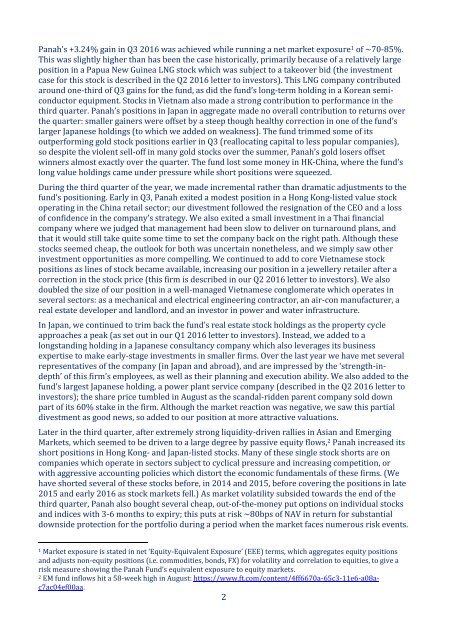Create successful ePaper yourself
Turn your PDF publications into a flip-book with our unique Google optimized e-Paper software.
Panah’s +3.24% gain in Q3 2016 was achieved while running a net market exposure 1 of ~70-85%.<br />
This was slightly higher than has been the case historically, primarily because of a relatively large<br />
position in a Papua New Guinea LNG stock which was subject to a takeover bid (the investment<br />
case for this stock is described in the Q2 2016 letter to investors). This LNG company contributed<br />
around one-third of Q3 gains for the fund, as did the fund’s long-term holding in a Korean semiconductor<br />
equipment. Stocks in Vietnam also made a strong contribution to performance in the<br />
third quarter. Panah’s positions in Japan in aggregate made no overall contribution to returns over<br />
the quarter: smaller gainers were offset by a steep though healthy correction in one of the fund’s<br />
larger Japanese holdings (to which we added on weakness). The fund trimmed some of its<br />
outperforming gold stock positions earlier in Q3 (reallocating capital to less popular companies),<br />
so despite the violent sell-off in many gold stocks over the summer, Panah’s gold losers offset<br />
winners almost exactly over the quarter. The fund lost some money in HK-China, where the fund’s<br />
long value holdings came under pressure while short positions were squeezed.<br />
During the third quarter of the year, we made incremental rather than dramatic adjustments to the<br />
fund’s positioning. Early in Q3, Panah exited a modest position in a Hong Kong-listed value stock<br />
operating in the China retail sector; our divestment followed the resignation of the CEO and a loss<br />
of confidence in the company’s strategy. We also exited a small investment in a Thai financial<br />
company where we judged that management had been slow to deliver on turnaround plans, and<br />
that it would still take quite some time to set the company back on the right path. Although these<br />
stocks seemed cheap, the outlook for both was uncertain nonetheless, and we simply saw other<br />
investment opportunities as more compelling. We continued to add to core Vietnamese stock<br />
positions as lines of stock became available, increasing our position in a jewellery retailer after a<br />
correction in the stock price (this firm is described in our Q2 2016 letter to investors). We also<br />
doubled the size of our position in a well-managed Vietnamese conglomerate which operates in<br />
several sectors: as a mechanical and electrical engineering contractor, an air-con manufacturer, a<br />
real estate developer and landlord, and an investor in power and water infrastructure.<br />
In Japan, we continued to trim back the fund’s real estate stock holdings as the property cycle<br />
approaches a peak (as set out in our Q1 2016 letter to investors). Instead, we added to a<br />
longstanding holding in a Japanese consultancy company which also leverages its business<br />
expertise to make early-stage investments in smaller firms. Over the last year we have met several<br />
representatives of the company (in Japan and abroad), and are impressed by the ‘strength-indepth’<br />
of this firm’s employees, as well as their planning and execution ability. We also added to the<br />
fund’s largest Japanese holding, a power plant service company (described in the Q2 2016 letter to<br />
investors); the share price tumbled in August as the scandal-ridden parent company sold down<br />
part of its 60% stake in the firm. Although the market reaction was negative, we saw this partial<br />
divestment as good news, so added to our position at more attractive valuations.<br />
Later in the third quarter, after extremely strong liquidity-driven rallies in Asian and Emerging<br />
Markets, which seemed to be driven to a large degree by passive equity flows, 2 Panah increased its<br />
short positions in Hong Kong- and Japan-listed stocks. Many of these single stock shorts are on<br />
companies which operate in sectors subject to cyclical pressure and increasing competition, or<br />
with aggressive accounting policies which distort the economic fundamentals of these firms. (We<br />
have shorted several of these stocks before, in 2014 and 2015, before covering the positions in late<br />
2015 and early 2016 as stock markets fell.) As market volatility subsided towards the end of the<br />
third quarter, Panah also bought several cheap, out-of-the-money put options on individual stocks<br />
and indices with 3-6 months to expiry; this puts at risk ~80bps of NAV in return for substantial<br />
downside protection for the portfolio during a period when the market faces numerous risk events.<br />
1 Market exposure is stated in net ‘Equity-Equivalent Exposure’ (EEE) terms, which aggregates equity positions<br />
and adjusts non-equity positions (i.e. commodities, bonds, FX) for volatility and correlation to equities, to give a<br />
risk measure showing the Panah Fund’s equivalent exposure to equity markets.<br />
2 EM fund inflows hit a 58-week high in August: https://www.ft.com/content/4ff6670a-65c3-11e6-a08ac7ac04ef00aa.<br />
2


